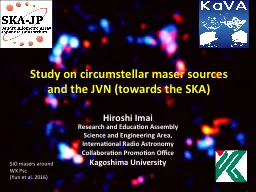

and the JVN towards the SKA Hiroshi Imai Research and Education Assembly Science and Engineering Area International Radio Astronomy Collaboration Promotion Office Kagoshima University SiO masers around ID: 649307
Download Presentation The PPT/PDF document "Study on circumstellar maser sources" is the property of its rightful owner. Permission is granted to download and print the materials on this web site for personal, non-commercial use only, and to display it on your personal computer provided you do not modify the materials and that you retain all copyright notices contained in the materials. By downloading content from our website, you accept the terms of this agreement.
Slide1
Study on
circumstellar maser sources and the JVN (towards the SKA)
Hiroshi ImaiResearch and Education Assembly Science and Engineering Area,International Radio Astronomy Collaboration Promotion Office Kagoshima University
SiO masers around WX Psc (Yun et al. 2016)Slide2
JVN image of H2
O masers around RT Virginis (u16150b, preliminary)
c.f. VLBA observations in 1998 (Imai et al. 2003)
0.29 Jy/beamTint= 2 hrSlide3
I
do not suggest intensive study on circumstellar masers with JVN.
Movie of SiO
masers around TX Cam
(Diamond &
Kemball
2003;
Gonidakis
et al. 2010;
Gonidakis
et al. 2013)
KaVA Large Projects
on
circumstellar
masers(2017—2025?)
Instead, I
do
suggest
some strategies
in
stellar maser study with JVN.Slide4
How is JVN characterized?
flexible ≠ systematicUnstable (errors, bad weather)→ compensated by flexibility
High sensitivity(c.f. EVN, HSA=High Sensitivity Array)High dynamic range (in full operation)Slide5
The Ibaraki Array
(first but last operation of …?)Baselines as short as 50 km (c.f. MERLIN)Slide6
Fringe fitting (rate) solutions for W
Hya @100 pc in u16150b
Extended circumstellar H2O masers with JVNSlide7
Microscopic view for exploring
macroscopic structure of CSEsBeaming angle ~apparent spot size/ spot distribution in maser features
⇩Important clues to CSE structureShock wave propagationor physical condition variation by star light
Richards (2010)Slide8
Periodic behavior of H2
O maser distributions?How to get visible and invisible?Compact spot visible in a specific pulsation phase?
Decadal evolution with mass loss history?(comparison with previous maps if available)
VLA (baseline 30 km) KNIFE (200 km)
VERA (1000 km)
KaVA
(400 km)
2005 January 20
2013 January 8
H
2
O masers in W
Hya
(Imai et al. 2016 in prep.)
Loose monitoring
of red supergiants
(Asaki et al.)Slide9
Decadal evolution of a water fountain source
W43AImai et al. (2002, 2007)Chong, Imai & Diamond (2015)
Dynamical age: ~50
yr (born around 1965)Slide10
Decadal evolution of
a water fountain sourceW43AImai et al. (2002, 2007)Chong, Imai & Diamond (2015)
Dynamical time scale ~ Dynamical age
(Imai et al. 2016 in prep.)Slide11
Circumstellar
envelope and its JVN’s view
ALMA / VLT
KaVA (dynamic) / ALMA (static)
KaVA (dynamic)
/ JVN (static)
APT
/ SKASlide12
Better with VLBA / EVN / HSA?
large / key projects drivenaffected by communities’ present-day trends
JVN operated by universitiesdecadal / centurial academic activitiesresearch time scale fixed by telescope lifetimelarge key projects followed by key projects (for < 10 years) proposed by same research groupSlide13
Towards era of the SKA
Collaboration with FAST will be pessimistic (?). Starting with P-band (300 MHz)?
Start with collaboration with SHAO, ATNF, UTasDomestic partners: ISAS (Usuda 64 m), NICT (Kashima 34 m) for L-bandCollaboration at C-band (6.7 GHz) promising?
Science in L-band VLBI: OH lines OH masers (MWG dynamics, stellar evolution) see Nakagawa-san’s talk
OH thermal line (absorption with AGNs)Developments towards the SKA
Wide-band system (1—25 GHz)Low cost, low power consumption equipment
Reliable system operation scheme
Calibration scheme against ionosphere
Wide field imagingSlide14
Conclusions
Consider JVN’s “legacy projects”. Decadal (loose) radio source monitoring Mapping stellar masers toward “progenitors” (
novas, SNe, WFs) Challenge new ideas flexibly. As pathfinder to SKA Anticipating trials for ALMA